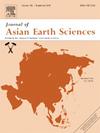基于多尺度环境噪声层析成像的东喜马拉雅结带Bomi地区高分辨率速度结构
IF 2.7
3区 地球科学
Q2 GEOSCIENCES, MULTIDISCIPLINARY
引用次数: 0
摘要
东喜马拉雅构造带北部的波米地区为大型走滑嘉利断裂所穿越。本研究旨在探讨渤密地区断裂带结构和局部构造应力。基于多尺度反演方案,利用Bomi密集阵列(207台短周期地震仪)的环境噪声记录,获得了0 ~ 4 km浅层地壳的三维高分辨率横波速度和各向异性模型。群速度的方位角各向异性表明,群速度的快速方向由北向南到东西向或由西向东由北向西-东南方向变化。这种变化可能与印度-亚洲碰撞的东北向构造应力、地壳物质向东挤压以及加里断裂的右走滑活动有关。v模式表明,沿嘉里主断裂的南部低速带主要受岩体破碎化的影响,而围绕嘉里次级断裂的北部低速带可能与沉积岩疏松和大量地热水有关。中部的高速可能反映了侵入岗底斯花岗岩的存在。此外,河谷区(帕隆藏布江和博堆藏布江)沉积物厚度分布极不均匀。柏堆藏布江的沉积物厚度一般大于帕龙藏布江。柏堆藏布江西侧的沉积层较东侧厚。本文章由计算机程序翻译,如有差异,请以英文原文为准。

High-resolution velocity structure in the Bomi area, Eastern Himalayan Syntaxis, constrained from multiscale ambient noise tomography
Bomi area in the north of Eastern Himalayan Syntaxis is traversed by the large strike-slip Jiali fault. This study aims to investigate fault zone structure and local tectonic stress in the Bomi area. The 3D high-resolution S-wave velocity (Vs) and anisotropy models of the shallow crust (0–4 km) are obtained using the ambient noise recordings from Bomi dense array (207 short-period seismometers) based on a multiscale inversion scheme. The azimuthal anisotropy of the group velocities shows that the fast directions change from N–S to E–W or NW–SE from west to east. This variation is probably affected by the northeastward tectonic stress from the India-Asia collision, eastward extrusion of crustal materials, and the dextral strike-slip activity of the Jiali faults. Vs model suggests that southern low-velocity belts along the Jiali main faults are primarily affected by rock mass fragmentation, and the northern low-velocity feature surrounding the Jiali secondary faults is probably related to the loose sedimentary rock and numerous geothermal waters. The high velocity in the central part may reflect the presence of intrusive Gangdese granite. Additionally, the sediment thickness distribution in the river valleys (Parlung Tsangpo and Bodui Tsangpo) is highly uneven. Sediment thickness in the Bodui Tsangpo is generally greater than that in Parlung Tsangpo. On the western side of Bodui Tsangpo, the sedimentary deposits are thicker than those on the eastern side.
求助全文
通过发布文献求助,成功后即可免费获取论文全文。
去求助
来源期刊

Journal of Asian Earth Sciences
地学-地球科学综合
CiteScore
5.90
自引率
10.00%
发文量
324
审稿时长
71 days
期刊介绍:
Journal of Asian Earth Sciences has an open access mirror journal Journal of Asian Earth Sciences: X, sharing the same aims and scope, editorial team, submission system and rigorous peer review.
The Journal of Asian Earth Sciences is an international interdisciplinary journal devoted to all aspects of research related to the solid Earth Sciences of Asia. The Journal publishes high quality, peer-reviewed scientific papers on the regional geology, tectonics, geochemistry and geophysics of Asia. It will be devoted primarily to research papers but short communications relating to new developments of broad interest, reviews and book reviews will also be included. Papers must have international appeal and should present work of more than local significance.
The scope includes deep processes of the Asian continent and its adjacent oceans; seismology and earthquakes; orogeny, magmatism, metamorphism and volcanism; growth, deformation and destruction of the Asian crust; crust-mantle interaction; evolution of life (early life, biostratigraphy, biogeography and mass-extinction); fluids, fluxes and reservoirs of mineral and energy resources; surface processes (weathering, erosion, transport and deposition of sediments) and resulting geomorphology; and the response of the Earth to global climate change as viewed within the Asian continent and surrounding oceans.
 求助内容:
求助内容: 应助结果提醒方式:
应助结果提醒方式:


